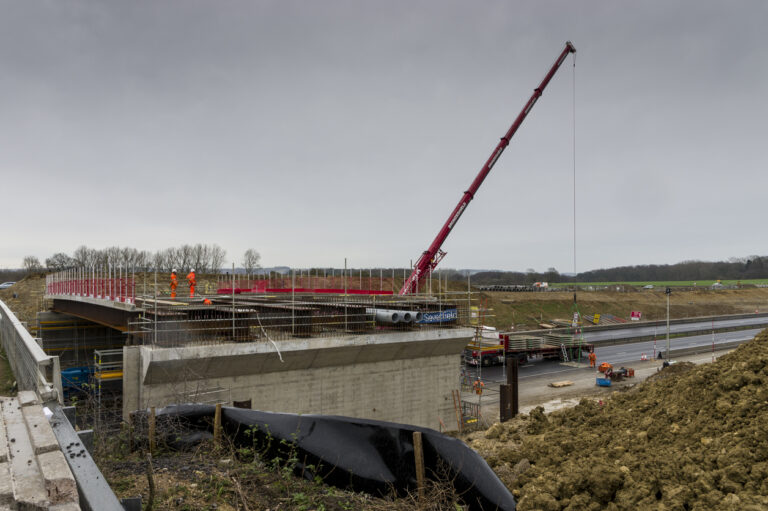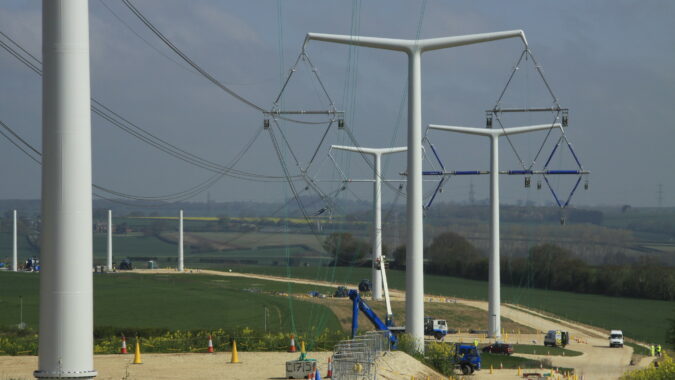Design & Funding
More efficient use of public and private money combined with sound design principles will deliver better outcomes for society.
Updated:

The Commission’s own recommendations are made within a ‘fiscal remit’ set by government. This currently provides a long term funding guideline for public investment in economic infrastructure of 1.1 – 1.3 per cent of GDP for the period 2025 – 55.
Around half of the infrastructure investment in the UK is financed and delivered by the private sector, with the cost eventually passed through to consumers and business. The Commission’s recommendations recognise that all major projects will come at a cost that needs to be carefully assessed against the full range of realistic benefits.
The Commission’s work seeks to understand what factors drive private investment in infrastructure and how the infrastructure industry is evolving, and to use this insight to advise government.
Commission analysis for the Second National Infrastructure Assessment indicates that overall investment needs to increase from an average of around £55 billion per year over the last decade (that’s around ten per cent of UK investment) to around £70 to 80 billion per year in the 2030s and £60 to £70 billion per year in the 2040s. It’s a significant increase and one that will be challenging to deliver; but the Commission believes it is what is required to achieve low carbon and resilient infrastructure that supports economic growth and protects the environment.
The Commission also works to encourage the adoption of sound design principles throughout the project lifecycle that will help save money, reduce risk, add value, support environmental net gain and create a legacy that looks good and works well. In its response to the first National Infrastructure Assessment, the government committed to ensuring there is a design champion on all new major infrastructure projects, in line with Commission recommendations. The Second National Infrastructure Assessment includes a recommendation that the Design Group will work with the Infrastructure and Projects authority to develop further guidance explaning how design leaders should develop and embed project design specific principles.
Design & funding data
A range of data sets relating to infrastructure design and funding is available to review on our Data pages. This includes data sets used in Commission reports, as well as historic data sets. Each can be reviewed online or downloaded.
Review dataNext Section: Key issues
Here you will find a summary of the Commission’s position on key issues emerging from our work related to design and funding.
Key issues
Here you will find a summary of the Commission’s position on key issues emerging from our work related to design and funding.
Better and faster decision making to support investment
The Second National Infrastructure Assessment sets out an ambitious programme of change and investment in the country’s infrastructure. Much of that investment will come from the private sector and to compete in a competitive global market for that investment, the UK must be able to attract investors based on the strength of its policy and regulatory environment, and the risk adjusted returns available from projects. In other words, it’s essential that government is able to make good decisions, fast.
To support that, the second Assessment set out a number of recommendationso to improve the infrastructure planning and regulatory regimes, to support better strategic policy direction from government, to boost the use of competition within regulated sectors, and to promote the benefits of good infrastructure design, which together can help secure private investment.
But effective policy and decision making are not just needed to support private sector investment: they are needed for effective decisions on public sector investment too. To that end, the Commission has recommended major infrastructure projects should be given separate budgets for their lifetime, with the largest projects given their own ‘departmental style’ settlements with explicit contingency budgets to ensure that cost or time overruns don’t prevent other smaller projects from being taken forward. Finally, government should account for maintenance and renewal spending separately from enhancements so that it does not get deprioritised.
Better design for all major infrastructure projects
The Commission’s Design Group was established in May 2019 following a recommendation in the first National Infrastructure Assessment which highlighted how projects can benefit from good design. Chaired by Professor Sadie Morgan, the Design Group brings together leaders from engineering, architecture, transport and landscape, to champion design excellence in infrastructure.
In February 2020 the group published Design Principles for National Infrastructure. This set out four principles – climate, people, places and value – that should guide the planning and delivery of major projects, with support from dedicated design champions on the project board. The government has subsequently committed to the principle of embedding good design in all infrastructure projects in its National infrastructure Strategy.
Design has sometimes been treated as an afterthought on major projects. These high level principles, the first of their kind for the UK, enable projects to deliver good design throughout the project lifecycle. They can be applied to all economic infrastructure: digital communications, energy, transport, flood management, water and waste.
In the Second National Infrastructure Assessment, the Design Group committed to developing further guidance that explains how design leaders, using an effective, structured process, should develop and embed project specific design principles. The Commission recommended that by 2024, the Infrastructure and Projects Authority should incorporate this guidance within its assurance review regime and expect all Nationally Significant Infrastructure Projects to follow it.
Evaluating projects and costs
The National Infrastructure Assessment recommended that the analysis of costs and benefits of private financing and traditional procurement should be improved by collecting data at appraisal stage, upon construction completion and in the operations phase to help provide a clear view on value for money over the whole lifecycle of a project.
To help with this process, in 2019 the Commission piloted a new analytical framework to guide the analysis of whole-life performance of private financed and traditional procurement infrastructure delivery models. It aims to ensure that government selection of infrastructure procurement models is made with a robust and comprehensive consideration of broader factors beyond financial cost.
The Commission has also looked at how to compare the value for money of different financing models for nuclear infrastructure.
Headline recommendations
Commit to long term funding to deliver low carbon heat
Government must commit long term funding to deliver low carbon heat across the public sector estate, social housing and for households on lower incomes by:
- allocating £28.9bn between 2024 and 2050 to deliver low carbon heat and energy efficiency improvements in the public sector estate, including across devolved administrations, and 75 per cent of this funding should be committed to 2035
- allocating £33.8bn between 2024 and 2050 to deliver low carbon heat in the social housing sector, and devolve funding to deliver the programme, and 35 per cent of this funding should be committed to 2035
- allocating £41.7bn between 2024 and 2050 to deliver low carbon heat to all other households on lower incomes, and 35 per cent of this funding should be committed to 2035.
Government should commit to long term funding of £22 billion for major transport projects in cities
Government should commit long term funding of £22 billion for major transport projects in cities from 2028 to 2045. The initial focus for this funding should be on those cities that are likely to have the greatest need for increased capacity, justifying investment in rail or tram type projects – the Commission’s analysis indicates that these cities are Birmingham, Bristol, Leeds and Manchester. Some of this funding should also be made available to other cities where there is likely to be a need for increased capacity or connectivity. To reflect the uncertainty over future travel demand and cost, the total investment package should be reappraised before final decisions are made on which projects to take forward
Cities benefitting from major transport projects should make a significant contribution to capital costs
The cities that directly benefit from the major transport projects outlined in recommendation 17 should make a significant contribution to the capital costs. Government should expect a local contribution of at least 15 to 25 per cent towards the total cost of the investment – although there are scenarios where a higher contribution may be expected, particularly for less expensive investments. Government and the UK Infrastructure Bank should work with cities to investigate and facilitate financing mechanisms and funding sources that could include a combination of business rates retention, third party contributions, forms of land value capture, and new income streams, to support the delivery of local public transport infrastructure.
Government should move faster in devolving powers and funding for local transport to local authorities
Government needs to move faster in devolving powers and funding for local transport to local authorities. By the next Spending Review, government should have agreed single multiyear financial settlements for existing mayoral combined authorities to invest in local priorities, and then continue to roll these out to new mayoral combined authorities. All county councils and unitary authorities that remain responsible for strategic transport planning should be provided with devolved five year transport budgets by the end of 2025, sufficient to cover maintenance, renewals and small to medium enhancements.
Government should ensure that £8 billion a year is available for devolved transport budgets for local authorities outside London, consisting of a combination of central government grants and locally raised funds.
Government should replace short term funding deals for TfL with five year funding settlements
21. Government should replace short term funding deals for Transport for London with five year funding settlements, sufficient to enable both the renewal and enhancement of London transport. Government should work with the Mayor of London to establish the priorities for public transport enhancements over the next ten-20 years and reach agreement on the appropriate combination of grant support, retained business rates and local mechanisms that can be used to finance and fund them
Empower regulators to facilitate strategic investments that address long term challenges of net zero, energy security and climate resilience
Government must empower regulators to facilitate investment in a strategic way that address the long term challenges of net zero, energy security and climate resilience by:
- setting out a long term strategic vision for each of the regulated sectors, through strategic policy statements, updated during each Parliament
- requiring regulators to enhance the role of competition by introducing legislation to remove any barriers to the use of competition and focusing ‘standard’ periodic price controls on the maintenance of existing networks and using tendering processes for strategic enhancements, with a clear, public justification required where tendering is not used.
Develop further guidance explaning how design leaders should develop and embed project specific design principles
The Design Group will develop further guidance that explains how design leaders, using an effective, structured process, should develop and embed project specific design principles. By 2024, the Infrastructure and Projects Authority should incorporate this guidance within its assurance review regime and expect all Nationally Significant Infrastructure Projects to follow it.
Reform public spending frameworks for infrastructure to provide longer term certainty and more effective management
By 2025, government should reform public spending frameworks for infrastructure to provide longer term certainty and more effective management by:
-
- setting fixed budgets for capital infrastructure for at least five years
- moving away from annual controls for major capital projects and instead giving major projects a fixed budget with the ability to move money forward and backward across years within that budget
- accounting for maintenance and renewal spend separately from capital or resource spend — these budgets should be set for at least five years, with departments identifying an indicative longer term pipeline that highlights any particularly large upcoming maintenance or renewal spend
- giving infrastructure ‘megaprojects’ their own ‘project expenditure limit’ including explicit contingency budgets, separate to the department which runs them
- adopting the funding profile set out by the Commission’s recommendations in future spending reviews.
Latest Updates

We’re recruiting – Infrastructure Funding, Financing & Regulation Lead
We are recruiting for an exciting new role in the Commission’s economics and modelling team, helping shape our policy on the cross-cutting themes of economic regulation, funding and financing in all the sectors in our remit. The successful candidate will be an infrastructure/capital financing expert, and/or a regulatory specialist. This is a new role in...

Views sought on project level design principles
Infrastructure professionals are being invited to share their views and experiences of working with project-specific design principles to help inform new national guidance. The National Infrastructure Commission’s Design Group, chaired by Sadie Morgan, is seeking input on how such principles can work in practice and examples of the difference they can make at different stages...

Cost effective delivery of infrastructure projects
Project exploring how the UK can build economic infrastructure more quickly and cheaply, and compare favourably with its international peers.

Government Expenditure on Economic Infrastructure
Data showing past government expenditure on economic infrastructure within the scope of the Commissions fiscal remit

Long term review sets out pressing need to modernise infrastructure to support economic growth and climate action
Improved infrastructure to boost economic growth across the UK and meet climate goals is both achievable and affordable if the right policy steps are taken now, according to the government’s independent advisers on infrastructure strategy. The Second National Infrastructure Assessment – a five yearly review conducted by the National Infrastructure Commission – sets out a...

Second National Infrastructure Assessment
The Commission's thirty year plan for a low carbon and resilient UK economy that supports economic growth and protects the natural environment

National Infrastructure Assessment
An analysis of the UK’s long term economic infrastructure needs, outlining a strategic vision over the next thirty years.

Stronger coordination of environment and community benefit needed to get planning timescales back on track
A new data platform to share environmental information and effective ways of addressing the impact of proposed infrastructure projects will enable stronger protection for natural habitats and speed up schemes crucial to the net zero transition, according to a new report by the National Infrastructure Commission. The review by the government’s official infrastructure advisers also...

Infrastructure planning system
A short study reviewing the current processes for reviewing national policy statements for key infrastructure sectors

Delivering net zero, climate resilience and growth

Go big where it counts to hit economic and climate goals, says Commission
Government must develop stronger staying power and focus on fewer, bigger, better targeted initiatives to deliver the infrastructure needed to meet its long term goals for economic growth and a lower carbon economy, the UK’s independent advisers on infrastructure have said. The last year has seen progress towards major infrastructure objectives “stutter further just as...

Infrastructure Progress Review 2023
Our annual monitoring report on government progress towards major infrastructure objectives.

Commission to review major projects planning policy
The National Infrastructure Commission has been asked to review the current approach to National Policy Statements (NPSs) and identify how the planning system could create greater certainty for infrastructure investors, developers and local communities. The independent advisory body has been commissioned to undertake the review as government prepares to publish an Action Plan on Nationally...

Letter to Planning Minister from Design Group Chair: Design excellence & National Policy Statements
Commission Design Group Chair Sadie Morgan has written to Lucy Frazer, the Minister of State for Housing and Planning at the Department for Levelling Up, Housing and Communities, setting out the value of including clear guidance on the value of design in all of the National Policy Statements which set the strategic priorities for the...

James Heath: Is the cost-of-living crisis an infrastructure crisis?
James Heath, Chief Executive of the National Infrastructure Commission, spoke at the London Infrastructure Summit today (10 November 2022) organised by BusinessLDN. In his remarks, James reflects on the challenges facing infrastructure sectors as they decarbonise, in particular the need for significant capital investment against a backdrop of economic constraints. James sets out the conditions...